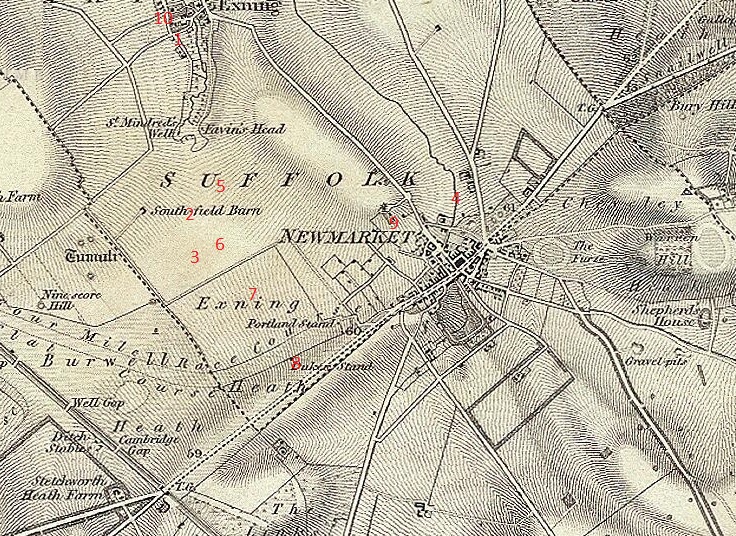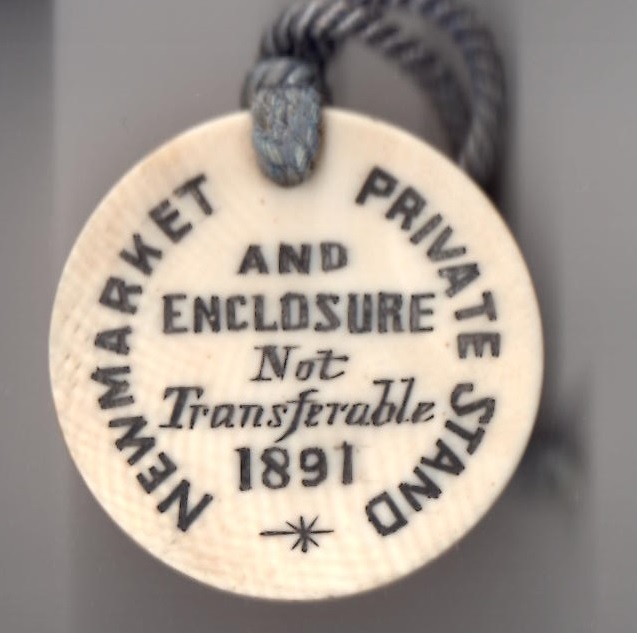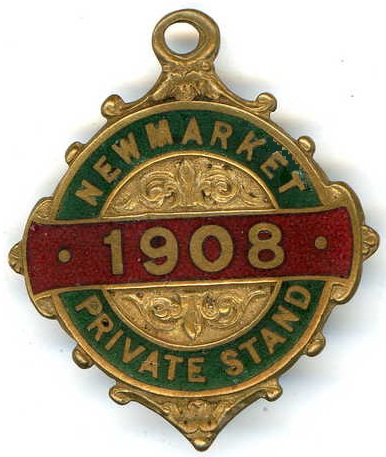John George Lambton, eldest twin son of George Lambton (2nd Earl of Durham) and his wife Lady Beatrix Frances, was born on 19th June 1855, the other twin being Frederick. John George served in the Coldstream Guards and, from 1884 until his death, served as Lord Lieutenant of the County of Durham. On the death of his father he inherited the title 3rd Earl of Durham along with his estates, which included Harraton House at The Lodge, Exning. He married Ethel Elizabeth Louisa Milner in 1882, marking the occasion by inscribing her initials EM on the arch of the central gable of Harraton Court Stables which were being built at the time, and which were completed in 1883. He was an avid racegoer, owning his own stud at Harraton Court, and employed Percy Peck as his private trainer at Harraton Court Stables from 1895, after Percy had left the employment of Sir John Blundell Maple at Falmouth Lodge stables. John George's brother, the fifth son of George and Beatrix, was named George, and launched his training career in 1892 based at Bedford Lodge Stables, eventually training no less than 12 English Classics. The marriage of Lord Durham and his wife did not produce any children and for much of the marriage she was committed to a mental institution. Lord Durham had to wait until late in his life to own a classic winner, but in 1927 he won the Epsom Oaks with Beam (SR 1909) at 4/1 when trained by Frank Butters and ridden by Tommy Weston. The 3rd Earl of Durham died on 18th September 1928 and his Harraton Estate passed to his twin brother Frederick Lambton.
1927 Epsom Oaks BEAM (SR 1909) 4/1 owned by 3rd Earl of Durham, trained by Frank Butters and ridden by Tommy Weston
For over 4 centuries racing has been staged in Newmarket, but how have the racecourses evolved from an initial starting point at Fleam Dyke Pumping Station, some 8 miles from the town, with a winning post barely 200 metres from the town centre, into two world recognized, excellent racecourses and a universal acceptance that Newmarket is the Headquarters of racing?
To access an interactive racecourse map showing over 50 individually named racecourses CLICK HERE. The map will enable you to:-
1. Determine when extended races over 8 miles, 6 miles and 4 miles began to be replaced by the courses now visited by thousands annually;
2. Consider how the challenge of crossing the Devil's Dyke was overcome;
3. Contemplate why the town no longer has a steeplechase course despite having at least 5 courses during the past 2 centuries;
4. Examine the practicalities of having up to 48 starting posts and winning posts;
5. Appreciate that it was not financially viable to have an open racecourse spread widely across the heath, with a finishing post barely 200 metres from the town centre;
6. Research how and why the Cambridgeshire Handicap has been contested over 3 different courses.
NOTE: The map does not make mention of 2 particular courses:-
(i) Sefton Course (also known as the Cambridge Road Course)
Source: 1970 Raceform. Used from 1959 to 1975.
(ii) New Circular Course
The Circular Handicap was run on Friday 29th October 1875 on the New Circular Course of about two miles.
Source: London Standard (30th October 1875): ''the horses started near the Turn of the Lands, ran back way of the Cambridgeshire Course towards the Ditch, and afterwards proceeded down the side of the Tan Gallop, and turned into the Rowley Mile near the Bretby Stakes starting post, finishing at the stand at the end of the flat. Except in the hollow near the Cambridgeshire start the runners should have been visible all the way if the sky had been bright and clear''.
Another report hoped that the Circular Handicap would become a feature in future programmes, as it would be contested in front of the new grandstand which would be completed in about a year and would be able to accommodate thousands.
(I am grateful to Tim Cox for bringing attention to these 2 courses.)
Enjoy researching the intriguing history of Newmarket and its many racecourses.

Percy William Hesseltine Peck was born in 1870 into a racing family, being the eldest son of Robert Peck who won the Epsom Derby twice, firstly in 1873 with Doncaster (SR 2000), and later with Bend Or (SR 2030) in 1880. Percy began training as soon as he completed his education, and aged just 19 he won the Chester Cup, then known as the Tradesman's Cup, for Sir John Blundell Maple with Millstream His father Robert had undertaken the management of Maple's horses, with the training of them handed over to son Percy. Having won the 1889 Tradesmen's Cup with Millstream, Percy achieved his greatest triumph for Sir John in the 1893 1000 Guineas with Siffleuse (SR 1784) the unfancied 100/1 winner ridden by Tommy Loates. The previous year had begun in exceptional style for Percy and Sir John, winning the Lincoln Handicap with Clarence and the Brocklesby Stakes with Minting Queen.
On 18th September 1928 the 3rd Earl of Durham, John George Lambton, died at his Harraton House residence and, since he did not have any children, his title and estate passed to his younger twin brother Frederick. In February 1929 the trainer Mr J H Crawford enquired, on behalf of Sir Victor Sassoon, about purchasing Harraton Stud Farm, but made it clear that Sir Victor had no intention of buying the other associated properties and land. The whole estate was subsequently purchased by Lord Glanley.
Frederick Lambton, who inherited the Harraton Estate from his twin brother after he died on 18th September 1928, subsequently sold the Estate to Lord Glanely who already owned La Grange Stables. Lord Glanely, William James Tatem, was born at Appledore, North Devon on 6th March 1868 and became a wealthy Cardiff ship-owned, owning the Lady Lewis Steamship Company which he renamed the Tatem Steam Ship Company in 1910. He married Ada Mary Williams on 14th September 1897 and they had one son, Thomas Shandon Tatem, who tragically died aged 6. Lord Glanely enjoyed horse racing and was chairman of both Cardiff and Chepstow racecourses. He won 6 English Classics, most notably the 1919 Epsom Derby with Grand Parade (SR 1968) and the 1930 Epsom Oaks with Rose of England (SR 1808). Lady Glanely died on 10th April 1930 and William did not remarry. In February 1934 Harraton House, the residential property, as well as Harraton Court Stables, Harraton Court Stud, 4 additional farms and 1082 acres was advertised for sale by auction by Lord Glanely. Despite a large crowd attending the auction in May 1934, no sale was made as the reserve price was not reached. Lord Glanely, who made his fortune from shipping, purchased La Grange stables in early 1920, employing a number of trainers during his ownership of La Grange, including W J Platt, Charles Marsh, Fred C Archer, Frank Barling and Captain Thomas Hogg, who provided him with a number of Classic victories. He also purchased Harraton House and Stables in 1934, regularly opening his gardens to local charities in Exning. He employed George Digby as his trainer at Harraton Stables. In February 1935 George Digby was taken seriously ill with an internal stomache complaint and was treated at a top London hospital. He returned to Harration House to complete his recuperation. When the Second World War broke out in 1939 La Grange was requisitioned by the British Army and Lord Glanely moved his horses to Manton. He was killed in an air-raid on Weston-super-Mare in June 1942 aged 74.
George Richard Digby, recognised as one of the best ever riders of Arab horses, was crowned champion jockey in Egypt on no less than 14 occasions. After a highly successful riding career George turned his hand to training, initially training privately for John Reid Walker in 1927, for whom he won back to back Ascot Gold Cups with Invershin in 1928 and 1929. He then moved to Harraton Lodge, owned by Lord Glanely, where he was a public trainer. He won the 1934 Ascot Stakes with Hands Off for Mr F Dennis, a Lincolnshire potato grower, and the 1935 Dee Stakes at Chester with Pry II for Mr H W W Simms when ridden by Charlie Smirke. The Smirke connection continued in 1939 when Charlie's younger brother Harry was apprentice to Digby, winning the Newmarket Apprentice Handicap aboard the George Digby owned Jolie Laide. Later George jointly owned a stud farm with jockey Joe Childs at Nazeing, Essex, and in the twilight of his career he owned and trained another Ascot Gold Cup winner in 1953 with Souepi ridden by Charlie Elliott.
William Gerard O'Gorman, universally known as Paddy, was born in County Cork, Ireland on 27th May 1913 and travelled across to England in 1934. He transferred to Newmarket after the War to work with Robert 'Jack' Colling, son of the famous trainer Robert Weston Colling, although he had never previously been involved in a formal racing environment, but he proved himself to be an accomplished horseman and was soon put in charge of Colling's Scaltback Stud. He started breaking in yearlings on his own account at Oaks Lodge before moving to Harraton Stables in Exning, and then next door at Harraton Lodge. In 1953 Paddy successfully applied for a trainer's license, and did well with a small string, winning the 1958 Newbury Spring Cup with Nicholas Nickleby, the 1958 Stewards Cup with Epaulette, and the 1958 King's Stand Stakes with Drum Beat owned by Jack Gerber. Gerber's racing manager Dick Whitford played a significant role in establishing Timeform along with mathematician Phil Bull. Paddy briefly lived in Shalfleet Cottage until the main house was ready in 1959, remaining at Shalfleet until he transferred to Graham Place in 1963.
1958 Newbury Spring Cup NICHOLAS NICKLEBY 7/1 owned by Jack Gerber, trained by Paddy O'Gorman and ridden by Joe Mercer
1958 Stewards Cup EPAULETTE 33/1 owned by Jack Gerber, trained by Paddy O'Gorman and ridden by Frankie Durr
1958 King's Stand Stakes DRUM BEAT 2/1 jt fav owned by Jack Gerber, trained by Paddy O'Gorman and ridden by Scobie Breasley
In October 1961 Brigadier Stephen G Galpin, who trained at Harraton Court Stables, lost his licence and was disqualified by the Stewards of the National Hunt Committee for running Loddon Ruby at an unrecognised meeting. Loddon Ruby was also perpetually disqualified. A year later his son Richard married Felicity Vivien Wright in Newmarket and by the 1970s the couple were living in Coronation Stables. The Galpin's sold Harraton House to Mr Cookson, while Harraton Court Stables were bought by Dave Thom.
Denis Rayson
Denis Rayson trained at the stables, which would later be named Queen Alexandra Stables, in the mid-1960s to 1974. During his time there he was great friends with Des O'Connor who stayed at the stables regularly. Des was an owner, a great student of the form book, and rode out on occasions. In 1971 he owned Major Rose, who had previously won the 1968 Cesarewitch. Also, in 1971 Denis Rayson took charge of Champion Hurdler Persian War in November. The champion remained with Rayson for the remainder of the 1971 and 1972 seasons. Persian War had landed the 1968, 1969 and 1970 Champion Hurdles, but the move to Rayson, in a bid to regain his form, did not work. He was soundly defeated by Bula, although he did run second in the Scottish Champion Hurdle behind Coral Diver. Denis Rayson retired in August 1974, unable to make the game pay in a period of financial restraint.
Peter Poston
Peter Poston, born on 28th July 1913, made his fortune in the 1960s as the boss of a highly successful business based at Smithfield meat market in London. He used his money to indulge in his passion, horse racing, and when he could not get ‘a desirable trainer' to train his horses for him he decided to train them himself. He applied for a Flat trainer's licence in 1962, launching his career training 20 of his own horses on his 120-acre Essex farm at Ingatestone. He must have thought the game would be easy when he scored with his very first runner, Faire La Nouba 25/1, at Lincoln which paid over £45 on the tote. He also won the Rosebery Stakes with Grand Avenue at 8/1. In 1969 he relocated to Exning, Newmarket, to train at what was then known as Raylands Stables on Rayes Lane. He insisted that he could run his stables, not as a profession but as a business, maximising the unique business opportunities on offer at that time. The Levy Board were keen to promote smaller racecourses, particularly those based in the North and in Scotland, by offering a travel grant of £35 per runner, equivalent today to £580. Poston, and his wife, purchased their own 8-box and 6-box horse carriers, cutting out the cost of a transport contractor, driving it to northern meeting themselves, occasionally spending the night in the box when attending Scottish meetings. He stationed the 6-box carrier at a yard he rented in Lanark which cruised between Lanark, Edinburgh, Hamilton and Stockton, and when the runners got tired Peter drove the 8-box north to supply it with fresh horses and to take the tired ones back to his yard. Peter exploited to the full the chance to transport 8 horses to Hamilton Park, Lanark, Catterick Bridge, or similar Northern courses, collecting £280 (equivalent today to £4640) from the Levy Board irrespective of whether his horses won win or place prize money. Furthermore, he was keen to create a family atmosphere within his stables by promoting the use of his own apprentices. It saved paying the riding fee of a professional jockey and gave opportunities for up and coming apprentices, including Bevan Freeman and Richard Hutchinson. Although he only had 36 winners between his launch in 1962 and his move to Newmarket in 1969, he was still able to run his stable profitably. He landed long priced winners like Dire Straits (50/1) and later (100/6) at Newcastle, Bramble (100/8), Patsy One (25/1), Grand Avenue (33/1) and Mill Green 8/1 and 10/1, although one of his best known, and best loved, horses was Pidgeon Toes. His star horse in the mid-1970s was Homefield, a 150 guineas purchase at the Newmarket sales, who achieved a winning sequence of 13 wins, 10 on the flat and 3 over the jumps, in the years between 1972 and 1976. He was renowned for running his horses frequently, often they went for long periods without winning, yet were still able to pay their way. The likes of Sound Advice lost 64 races but won at Lanark on Friday 24th June 1966 when 6/4 fav ridden by Bevan Freeman. Peter retired in 1981 and died in 1991 aged 77.


2006-present Gay Kelleway
Gay Kelleway, daughter of the late jockey and trainer Paul Kelleway, began training in her own right at Charnwood Stables in 1991, saddling her first winner, Aberfoyle, at Lingfield Park in January 1993. She then moved to Eve Lodge Stables for the 1995 season, before transferring to Whitcombe Manor Stables in Dorset. She then spent a considerable period training at Lingfield Park before moving back to Headquarters in 2006. She currently trains 30 horses at Queen Alexandra Stables in the village of Exning, on the edge of Newmarket, a stable she named after the Royal Ascot race she won as a jockey in 1987 riding Sprowston Boy for her father, Paul. In 2011 she won a race potentially more important to her than her Royal Ascot victory when Layline won the Paul Kelleway Memorial Stakes at Lingfield. Such has been her success at Queen Alexandra Stables that she felt she needed to expand her capacity, taking on a barn for 15 horses at Red House Hill Stables in 2017.
2011 Paul Kelleway Memorial Classified Stakes at Lingfield LAYLINE 5/1 owned by the Whispering Wind & Partners, trained by Gay Kelleway and ridden by Robert Winston



